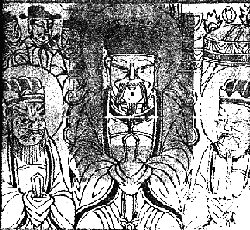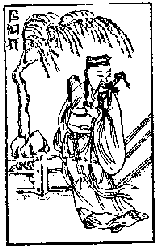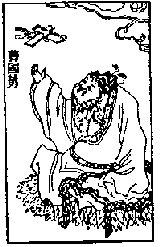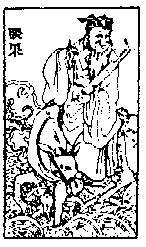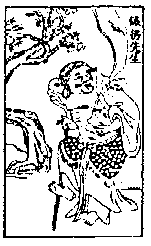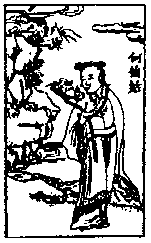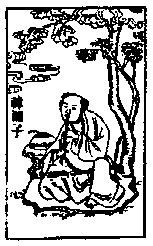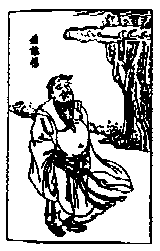


Buddhist Gods and Goddesses
| Please consider making little donation to help us expand the encyclopedia Donate |
In addition to following the teachings of Buddha, most Buddhists also recognize various gods and demons, many of which take on different forms. Many Buddhist also recognizeHindugods, Taoistgods, local deities partly out of respect and partly so as not to offend them. Belief in these gods somewhat goes against Buddha’s teachings. The Buddha did not claim to be of divine origin nor did he claim revelations from heaven or meditate or pray a higher being.
The Buddhist pantheon of gods is derived mainly from Hinduism, Indianfolkreligions, and local religions where Buddhism took root. In many cases characteristics of gods from different faiths are merged into a single god. A Buddhistgod, for example, may have been derived from Hindugod and given characteristics of a local spirit. Moreover, the gods are intended to show the many sides of enlightenment: it has wrathful, vengeful sides as well as its peaceful and beneficent side.
Gods, angels, or celestial beings are sometimes referred to as devas , derived from the old Sanskrit div , meaning brightness. Hindususe the word to describe their gods. For Buddhists, describing devas as gods is not completely accurate. They are seen more as beings that are neither human or animal but are regarded as above human. All devas were humans at one time and may become humans again.
In many cases the worship of spirit and gods is seen as kind of an every matter, incorporating animist beliefs that predate the emergence of Buddhism. One Burmese man told National Geographic, "Buddhism is concerned with the hereafter; we placate and propitiate the nats in this world."
The Buddha himself had little to say about god. His message was about enduring the suffering in the world if they put a lid on their desires bot seeking salvation in the afterlife.
Websites and Resources: Buddha Net buddhanet.net/e-learning/basic-guide ; Victoria and Albert Museum vam.ac.uk/collections/asia/asia_features/buddhism/index ; ReligiousTolerance Page religioustolerance.org/buddhism ; Wikipedia article Wikipedia ; Internet Sacred Texts Archive sacred-texts.com/bud/index ; Introduction to Buddhismwebspace.ship.edu/cgboer/buddhaintro ;
Books: Buddhism by Christmas Humphrey (Pelican); Buddhism Explained by PhraKhantipalo; BuddhistDictionary by MahatheraNyanatiloka; Siddhartha by Herman Hesse. Also recommended are books by the Dalai Lama, Robert Thurman, a respected Buddhist scholar and former Tibetan Buddhistmonk; and Thich Nhat Hanh, a Buddhist monk from Vietnam who has been involved with various anti-war activities. Film: Little Buddha
Websites and Resources on Buddhist Art: buddhism.org/board/main.cgi?board=BuddhistArt ; Buddhist Images buddhistimages.co.uk ; Religion Facts Images religionfacts.com/buddhism/gallery ; Buddhist Symbols viewonbuddhism.org/general_symbols_buddhism ; Buddhist Artwork buddhanet.net/budart/index ; Buddhism Images freewebs.com/buddhaimages ; Wikipedia article on Buddhist Art Wikipedia ; Buddha Images http://www.buddha-images.com/ ; Buddhist Art artlex.com/ArtLex/b/Buddhism ; Huntington Archives Buddhist Art kaladarshan.arts.ohio-state.edu ; Buddhist Art Resources academicinfo.net/buddhismart
Buddhists do not believe in God as a creator and sustainer of the universe. The Buddha once said that the notion of a single Creator God began as a rumor invented by Brahma, one of the three most important Hindugods.
"Now there comes a time when this world begins to evolve, and then the World of Brahma appears, but is empty." Buddha said, "And some being, whether because his allotted span is past or because his merit is exhausted, quits his body in the world of Radiance and is born in the emptyWorld of Brahma, where he dwells for a long time. Now, because he has been so long alone he begins to feeldissatisfaction and longing, and he wishes that other beings might come and live with him. And indeed soon other beings quit their bodies in the World of Radiance to keep him company in the World of Brahma."
"Then the being who was first born thinks: "I am Brahma, the mighty Brahma, the Conqueror, the Unconquered, the All-seeing, the Lord, the Maker, the Creator, the Supreme Chief, the Disposer, the Controller, the Father of all that is or is to be. I have created all these beings, for I merely wished that they might be and they have come here! And the other beings...think the same, because he was born first and they later."
Guanyin There are hundreds of gods in the Buddhist pantheon. Many have been borrowed from the Hindupantheon to serve a particular purpose in Buddhist cosmology. Some have a humanlike appearance. Others look like monsters. Many have multiple arms and heads and hold various objects and display certain body positions and hand gestures that have symbolic meaning. At temples some serve as guardians and protectors at the entrance gates. Images found in temples vary according to sect and the period in which the temple was constructed. Gods, goddesses, and other celestial being tend to play a bigger role in Mahayana Buddhism than Theravada Buddhism. Mahayana Buddhismintroduced a number of female deities.
Buddhist gods include Avalokitesvara (the eleven-headed God of Mercy), Panchika (god of riches), Harati (goddess) of fertility), Garuda (mythicalbird), Yakshas and Yakshhis (male and femalespirits associated with fertility), nagas (mythicalserpentgods), Kinaras, or gandharvas (celestial musicians), Guanyin (Buddhist-Taoist goddess of Mercy), asparas (angels) dharmpalas (demonlike creatures that stomp on humanbodies). Some have been adapted from the Hindupantheon. Some have been taken outright from the Hindupantheon.
As is true with Hindugods many Buddhist gods have different manifestations. Avalokitesvara appears in 33 different manifestations. One reason for this is that locals were absorbed into the Buddhist pantheon by making them manifestations of existingBuddhist gods.
Naga, the serpentking, protected Buddha when he sat under bodhi tree before his enlightenmentKshitigarbha, Lord of the Netherworld, holds a staff and looks after the welfare of the deadSamantabhadra dispenses talismaic formulas which avert dangers and is often depicted riding on a white elephant.
AvalokiteshvaraAvalokitesvara (meaning “Lord Who Looks Down”) is arguably the most common and popular Buddhistcelestial being. Regarded as a god, a goddess and a Bodhisattva and featured prominently in the Lotus Sutra, he is closely associated with Amitabha and lives between births in Amitabha’sWestern paradise.
Avalokitesvara has a number of body parts and objects with symbolic meaning. Of his 11 heads, the central head one at the top belongs to Amitabha. He often has multiple arms, sometimes more than a thousand of them. The central pair of hands is in the cupped position representing respect. In one hand he hold a lotus, symbolizingenlightenment, In another he holds a bow and arrow, symbolizing a Bodhisattva’s ability to get at the heart of the matter.
Avalokitesvara appears in 33 different manifestations and 108forms, including the goddess of mercy, popular with pregnant mothers and invoked by people in trouble. Simply repeating her name several times is considered enough to drive away evil.
Harati
Hariti was a fearsome femaledemon that originated in India and had more than 500 children that she loved dearly. To satisfy her hunger, however, she hunted children of local people who sought the Buddha for help. Buddha kidnapped and hid Hariti’s youngest and most beloved child. The demon was filled with despair. Realizing the pain she causedother, she vowed never to hunt children again and was so repentant that she became a special protector for children and mothers. In return Buddhataught to her to satisfy her hunger with pomegranate seeds.
Like many Indiandeities, Hariti was adopted into the Buddhist pantheon that was later transmitted to China and from there to Japan, where she his now known as Kishimoji or Kishibojin, a popular god with women who want children and expecting mother who want a safe and easy birth. The deity also looks after the health and safety of young children. Pomegranate trees are often planted at temples that honor her.
Vajradhara The pantheon of gods in Tibetan Buddhism is derived mainly from Hinduism, Indian Buddhism and the Bon religion. In many cases characteristics of gods from all three faiths are merged into a single god. A Buddhistgod, for example, may have been derived from Hinduism and given characteristics of a Bon religionspirit. Moreover, the gods are intended to show the many sides of enlightenment: a particular god may have a wrathful, vengeful side as well as a peaceful and beneficent side.
HimalayanBuddhistsrecognize several thousand gods and demons, many of which, like their Hindu counterparts, take on many forms. Each village and sect has its ownpantheon of gods, spirits and demons. Rivalries between different groups and sects are often based on which gods are given the greatest importance. Many monasteries contain Tara figures that are said to have miraculously materialized out of thin air.
There are many general protectorgods called "dharmapalas" and personal meditation deities called "yidams" (which can either be male herakas or femaledakinis). Protector deities have both wrathful and benign manifestations. Their expression of rage or passionpack a great amount of energy. High mountains are believed to be dwelling places for a number of gods. Tibetans shout "Victory to the gods" as a greeting to these deities when they are in mountains. Sometimes deities are pictured at the center of mandalarepresentations of the worlds the inhabit.
A number of historical figures are treated with same reverence as gods. See Guru Rinpoche, Tsongkhapa, the 5th Dalai Lama. King Songtsen Gampo, King Trisong Detsen and Milarepa.
A typical deity such as Sambara has a consort, Vajravarahi, and an escort of 12 dakinis, deities who represent femalewisdom. Demons are believed to be responsible for a number of ills and misfortunes. The Mustangese recognize 416 demons of land, sky, fire and water. These demons are believed to cause 1,080 known diseases and five forms of violentdeath.
DipamkaraBuddhists tend to look upon gods in a different way than Westerners. Tibetangods, one religiousscholar wrote, represent "mental states evoked in meditation and ritual, a means of training the mind toward a more accurate appreciation of the humancondition."
Japanese Tempe Guardian Many gods in Japan have both non-Japanese origins. Hotei, one of the seven gods of good luck, is the god of happiness. A common symbol throughout Asia, he is jolly fellow with a big grin, pot belly and a bag sack. His ancestors can be traced back to a real human being, a Chinesemonk associated with the Chinesesect that gave birth to Zen Buddhism. Hotei is a bit like a year-round Santa Claus, traveling around the countryside with his sack, givingfood and necessities to the poor and needy and giving out presents to those who deserve them. Benzaiten, another one of the seven gods of good luck, is the goddess of art. Wiseand skilled in painting and writing, she carries a biwa (mandolin) and is often escorted by a sea snake. Originally a spirit of flowing water with her roots in India, she is the patronsaint of musicians and performers. Shrines for her with images of snakes are often set up near ponds.
Bishamon is the god of war and the protector of Buddhism, scared mountains, temples and cities. Usually depicted with a helmet, suit of armor and spear, he was originally a folkgod in India and was adopted by Buddhism. He is often found at the north gate or entrance of a building and is skilled at turning away evil spirits that causepoverty and bring bad luck.
Important gods and Bodhisattvas in Japan include Kannon, the 1,000-armed, 11-faced goddess of mercy; Jizo (often portrayed with children in his arms), a Bodhisattva who helps children and travelers; Fudo Myoo, a protector against danger and king of wisdom; Yakushi (Bhaisajaguru), the healer of the mind and body; and Amida (literally meaning “infinite light” or “infinite life”), the Buddha of the Western Paradise.
Bato Kannon, Horsehead Kannon, is a manifestation of Kannon often depicted in small stone statues of Kannon with a horse popping out of her hair or headdress. She specializes in caring for the souls of animals and other nonhuman creatures. The god of thunder is portrayed as a snake.
Jizo is a patron for travelers and children. He helps children build walls in the underworld and is associated in Japan with helping aborted fetuses and children who died young. According to tradition, Jizo was an Indianmonk who became a Bodhisattva. In India he was known by a different name. There is no evidence that he ever had a large following there. In China he gained a reputation for beingcompassionate and helping people to avoid reincarnation as terrible beasts.
Jizo didn’t develop a large following until he arrived in Japan. His association with rescuing people from unfortunate births was focused on children who died in the hope that they would have good afterlives. Jizo developed a particularly large following among women, who placed statues of him along roadsides and in Buddhisttemples. Over timestatues of Jizo changed from large ones of a dignified man to small ones of childlike man with a bald head. When abortions became commonplace in Japan places on hillsides were set aside for thousands of jizostatues.
Jizostatues are often found in groups of six, each with their hands in a different mudra (position) and each linked to relieving the pain of residents of the six realms of Buddhist cosmology: 1) one holds his hands in a praying position next to his chest and is associated with the Amida Buddha and the realm of humans: 2) one holds a sacredjewel and holds his hand in the no fearmudra and is associated with deva living on Mt. Sumisen; 3) one holds a set of Buddhistrosary beads and is associated with the realm of the non-human creatures; 4) one holds a sacredjewel and a pilgrimsstaff and is associated with Ashura, the realm of the deities; 5) one holds an incensebanner and is associated with hell; and 6) the last one holds an incense censer and is associated with the realm of the hungry spirits. The six statues are grouped to together because the people who placed them there may not know where their deceased loves ones are and thus say prayers to the entire universe and all realms to reach them.
MahakalaGuardian KingDhritarastra Chokyoing (Lokpalas) are the Four Guardian Kings. Often found at the entrance hallway of monasteries and believed to be Mongolian in origin, they protect the four cardinal directions. The eastern king is white and carries a lute. The southern king is blue and carries a sword. The westernking is red and carries a thunderbolt. The northern king is yellow and carries a banner of victory and a jewel-spitting mongoose. He is regarded as the god of wealth and is depicted riding a snow lion.
Dorje Jigje (Yamantaka) is the most well-known protector of the Yellow Hat sect. Known as the destroyer of Yama, the Lord of Death, he is a blue, beastly-looking creature with eight heads, one of which is the head of a bull, and strings of skulls around his waist and neck. He holds a flaying knife and a skull cup in his eight to 36 arms. With his 16 feet he stomps on eight Hindugods, eight mammals and eight birds. Dorje Jigje punishes evilpeople to a life in hell, helps guide good people to a better rebirth and crushes earthlypassions that block enlightenment. Yamanataka is so horrible that no one should look at his image, especially women. Statues of him are often covered.
YamantakaNagpo Chenpo (Mahakala) is wrathfulTantricgod and a manifestation of Chenresig (Avalokiteshvara). Associated with the HindugodShiva, he is blue and has fanged teeth, a crown fo skulls, and carries a trident and skull cup. He comes in various forms, with two to six arms and is regarded as the protector of tents by nomads. Nangpo Chenpomeans the Great Black One .
Tamdrin (Hahagriva) is another wrathfulmanifestation of Chenresig (Avalokiteshvara). Associated with the HindugodVishnu, he is red with a white face on the right and green gace on the left and has a horse’s head in his hair, a crown of skulls, a tiger skin around his waist and a garland of 52 chopped off heads. On his back are the wings of Garuda. In his six hands are a lotus, club sword, skull cup, snare and ax. Under his four legs a sun disc and corpses. Tandrin in red and Dorje in blue often serve as guardian gods at the entrance of temples.
More Tibetan BuddhistProtector Deities
MahakalaChanDorje (Vajrapani) is the wrathfulBodhisattva of Energy. He is blue with a tiger skin around his waist and snake around his neck. In his right hand is a thunderbolt, the symbol of the Tantricfaith. ChanDorje means “thunderbolt in hand.”
Demchok (Chakrasamvara) is a meditational deity with a blue body, 12 arms, four faces, and a crescent moon in his topnot. In his hands are a thunderbolt, a bell, a elephantskin, an axe, a hooked knife, a trident, a skull, a hand drum, a skull cup, a lasso and head of Brahma. He wears a tiger skin and has a garland with 52 severed heads around his neck.
Palden Lhamo (Shri devi) is the guardian of Lhasa, the Dalai Lama an the Yellow Hat sect. An angrymanifestation of Tara The female counterpart of Nagpo Chenpo (Mahakala), she is blue, wears tiger skin and humanskinclothes and has earrings made of a snake and a lion and carries a skull cup full of blood in her left hand and a club in her right hand. A moon is in her hair; the sun is her stomach; and a corpse is in her mouth.
Image Sources: Wikimedia Commons, Ray Kinnane, Simhe
Text Sources: WorldReligions edited by Geoffrey Parrinder (Facts on File Publications, New York); Encyclopedia of the World’s Religions edited by R.C. Zaehner (Barnes & NobleBooks, 1959); Encyclopedia of the World Cultures edited by David Levinson (G.K. Hall & Company, New York, 1994); The Creators by Daniel BoorstinNational Geographicarticles. Also the New York Times, Washington Post, Los Angeles Times, Smithsonian magazine, Times of London, The New Yorker, Time, Newsweek, Reuters, AP, AFP, Lonely Planet Guides, Compton’s Encyclopedia and various books and other publications.
Source
The Taoist Deities
The religious current of Taoism evolved its own pantheon of deities that were worshipped in temples by the various sects. These Taoist deities, like the Buddhist or Hindu pantheon, represented different qualities and attributes and various ceremonies, depending on circumstances were conducted to appeal to them.
Yu-huang -- The Jade Emperor
Yu-huang is the great High God of the Taoists -- the Jade Emperor. He rules Heaven as the Emperor doe Earth. All other gods must report to him. His chief function is to distribute justice, which he does through the court system of Hell where evil deeds and thoughts are punished. Yu-huang is the Lord of the living and the dead and of all the Buddhas, all the gods, all the spectres and all the demons.
According to legend he was the son of an emperor Ch'ing-te and his wife Pao Yueh-kuang who from his birth exhibited great compassion. When he had been a few years on the throne he abdicated and retired as a hermit spending his time dispensing medicine and knowledge of the Taoist texts. Some scholars see in this a myth of the sacred union of the sun and the moon, their son being the ruler of all Nature.
"The good who fulfill the doctrine of love, and who nourish Yu-huang with incense, flowers, candles and fruit; who praise his holy name with respect and propriety -- such people will receive thirty kinds of very wonderful rewards."
--Folkways in China L Holdus.
Yuan-shih T'ien-tsun -- The First Principal
Although Yu-huang is the High God, there are other abstract deities above him. He rules; they simply exist and instruct. First and foremost is Yuan-shih T'ien-tsun - the First Principal.
He has no beginning and no end. He existed "before the void and the silence, before primordial chaos." He is self-existing, changeless, limitless, invisible, contains all virtues, is present in all places and is the source of all truth.
San-ch'ing -- Three Pure Ones
These are the so-called Three Pure Ones. They are Yu-ch'ing (Jade Pure), Shang-ch'ing (Upper Pure) and T'ai-ch'ing (Great Pure). They are believed to be different manifestations of Lao Tzu. They are not rulers, but rather seek to save mankind by teaching and benevolence.
In a place with Yu-ch'ing lives Yuan-shih T'ien-tsun and the Holy Men (sheng-jen). With Shang-ch'ing lives Ling-pao T'ien-tsun (Spiritual Treasure Honoured by Heaven) and the Heroes. T'ai-ch'ing is the direct manifestation of Lao Tzu. He holds a fan, symbol of his powers, on which are written the yin-yang symbol and the Big Dipper.
San-kuan -- Three Officials
The San-kuan rule over all things in the three regions of the universe, keep a register of good and evil deeds and award good or bad fortune accordingly. T'ien-kuan, the Ruler of Heaven, grants happiness. Ti-kuan, Ruler of Earth, grants remissions of sins, and Shui-kuan, Ruler of Water, averts all evil. Their compassion for all people is unbounded. The San-kuan originated in a rite from the time of the Yellow-Turban Taoists.
"You, poor miserable people, ill-clad and destitute of worldly comforts, weighted down beneath the burden of labour and affliction, keep abstinence, and having taken a purifying bath, recite a thousand times the prayer in honour of the Ruler of Heaven." --Recherches sue les superstitions en Chine, Henri Dore.
San-yuan -- Three Epochs (or Principals)
The San-yuan originate from a time in the Eastern Chin Dynasty (317-420 A.D.) when the year was divided into three unequal periods. Shang- yuan ruled the first six moons (winter and spring); Hsia-yuan ruled the 7th and 8th moons (summer); and Chung-yuan ruled the 9th to 11th moons (fall). It was believed that they dwelled in the North Star (tzu-wei).
T'ien-shih
T'ien-shih was the title awarded to Chang Tao-ling (157-178 A.D.), the founder of the Yellow Turban Taoists (he is also claimed as founder by the Cheng-I and Five Bushels of Rice sects). It is believed that he received the Ling-pao (spiritual Treasure) Scripture written on golden tablets, from the Gods. He succeeded in finding the elixir of immortality, swallowed it, and ascended to Heaven, leaving his secrets, including his seals and demon-dispelling sword, with his son.
Since then the title T'ien-shih has passed through the family for generations. The current (63rd) Chang T'ien-shih lives in Taiwan and heads the Five Bushels of Rice Taoist sect. He continues to retain the sword and seals of Chang Tao-ling.
Pa-hsien -- Eight Immortals
These are popular deities modeled on historical figures. They were believed to live in grottos in Heaven. They are:
Lu Tung-pin
Lu Tung-pin (755 - 805 A.D.) was a scholar, doctor and official. He became a Taoist after a long and distinguished life as an official which ended in disgrace. He was very popular in his life and after his death became venerated as the King of Medicine. He represents the wealthy and literacy.
Ts'ao Kuo-chiu
Ts'ao Kuo-chiu represents the nobility for he was connected with the Imperial Sung Dynasty. His brother committed a crime for which he was ashamed and he retired and became a hermit who studied the Tao and learned the recipe for perfection. He holds in his hands the tablet that admits one to an audience with the emperor.
One day Han Ching-li and Lu Tung-pin found him and asked him what he was doing. He replied that he was studying the Tao. "What is that and where is it?" they asked. He pointed first to the sky and then to his heart. Then they realized that he understood and they gave him the recipe for perfection.
Chang Kuo-lao
Chang Kuo-lao was once the head of the Imperial Academy but he retired to live as a hermit on Mt. Chung-t'iao in Shansi. He was summoned to court by the Empress Wu (684-705 A.D.) however, when he reached the Temple of the Jealous Woman he fell down dead. Shortly afterwards he came back to life.
He had a magic mule which could travel thousands of miles a day. When he reached his destination the mule would turn to paper and Chang Kuo-lao could fold it up and put it in his pocket. To revive it he unfolded it and spurted water on it with his mouth. He is often pictured riding the mule, facing the tail.
Li T'ieh-kuai
Li T'ieh-kuai has an iron crutch and a black face. He represents the crippled and deformed. He tries to alleviate human suffering. He was taught to be an immortal by Hsi-wang-mu, Queen of the Immortals.
One day, when his soul went to Mt. Hua he told his disciple to guard his body and cremate it after seven days if he had not returned. On the sixth day the disciple's mother fell ill and so leaving to take care of her he burnt the body a day early. Li T'ieh-kuai's soul on returning could find no body so it entered that of an old man who had just died. Only then did he discover that it was a cripple. At first he wanted to leave it but Lao Tzu persuaded him to stay and gave him a golden circlet and an iron crutch.
He carries a gourd with him in which he keeps medicine to help people. Some say that it contains the elixir of life made from the peaches of immortality that grow in Hsi-wang-mu's garden.
Ho Hsien-ku
Ho Hsien-ku is represented holding a lotus blossom (a symbol of purity) and a peach. The legend is that she lived in the time of the Empress Wu (684-705 A.D.) in the Yun-mu (Cloud Mother) Mountains.
One night she had a dream that she should grind up a stone called Yun-mu and eat it. She did and vowed chastity at the same time. She then floated from mountain peak to peak gathering fruits which she gave to her mother (she having no need to eat). The Empress heard of her and summoned her to the court but on the way she disappeared. In this way she became an immortal.
She is a patron deity of women.
Han Hsiang-tsu
Han Hsiang-tsu represents youth. He was the grand nephew of Han Yu (768- 824 A.D.) who was a minister to Emperor Hsing-tung. He is reported to have accomplished all manner of remarkable feats including the production of extraordinary plants.
He became an immortal by eating one of the peaches of immortality. He carries with him a basket of fruit or flowers.
He was a disciple of Lu Tung-pin.
Han Chung-li
Han Chung-li represents military men. He lived during the Han dynasty when he was a Marshall of the Empire. In his old age he became a hermit and lived on Yang-chiu Mt. in Shansi where he met the Five Heroes who taught him how to be an immortal. This knowledge he taught to Lu Tung-pin.
During a famine he turned base metals into silver which he distributed to the poor people. He is recognized as a figure who holds a fan or a peach.
When he achieved immortality he was carried by a stork into the Heavens. Another legend has it that the wall of his hut burst open to reveal a casket in which were instructions on how to become an immortal.






